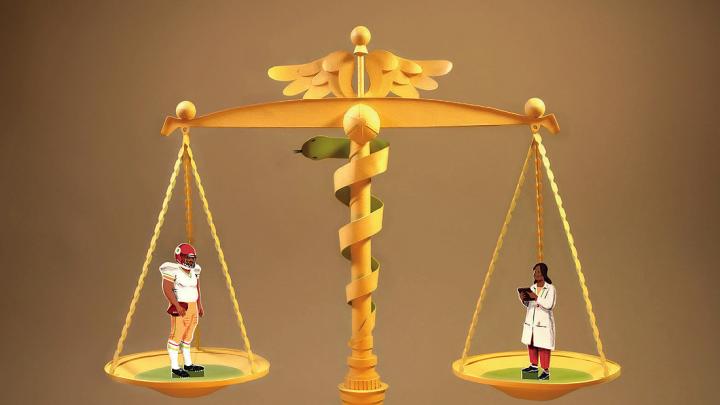Alarmingly, the rate of obesity in the United States has tripled during the past six decades: according to the Centers for Disease Control and Prevention, nearly 42 percent of American adults are obese. Globally, more than a billion people live with the condition, according to an analysis published in The Lancet in March, which found that, worldwide, the prevalence of obesity has more than doubled among adults since 1990, while quadrupling among children and adolescents. Decades of public awareness campaigns about the tremendous physical and mental health toll of the condition and coordinated efforts to promote healthier eating and exercise have failed to stem what the World Health Organization has called “an escalating global epidemic.”
Many obesity experts argue that an oversimplification of this complex condition, particularly the reliance on body mass index (BMI)—a simple calculation of weight in kilograms divided by height in meters squared—has hindered effective prevention and treatment efforts. BMI as a measure of obesity, they say, has diagnostic limitations, a problematic history in which white males were the measure of normal body types, and a tendency to make weight the focus of concern rather than a person’s overall health.
“People don’t want to get into the complexity of obesity because it’s like getting into murky waters,” says associate professor of medicine Fatima Cody Stanford, an obesity specialist at Massachusetts General Hospital. She and other experts have begun to reckon with the crisis anew: a commission convened in 2023 by The Lancet is devising a more holistic clinical definition for obesity and updated diagnostic guidelines.
While BMI is useful for tracking population-level trends, Stanford says, it’s much less insightful for judging any individual’s health. For example, given the weight of muscle tissue (which is denser than fat), many athletes have high BMIs. A 2019 study of several hundred Division One college football players found that the average BMI for athletes at every position would qualify as overweight (defined as BMI above 25) or obese (BMI above 30). Even nonathletes with higher BMIs can live without serious health harms from their larger bodies, notes Stanford: “Some people that come in with excess adipose, i.e., fat, may actually be much healthier overall than people who are much leaner,” she says.
Diagnostic imprecision is not BMI’s only shortcoming. The basic metric was conceived in the 1830s by a Belgian polymath named Adolphe Quetelet, to help statistically quantify “the normal man,” in work that helped forge the pseudoscience of eugenics. The “Quetelet Index” was eventually adopted as a health metric in 1972 by the American physiologist Ancel Keys, who renamed it body mass index and extolled its epidemiological utility in a study of some 7,400 “healthy men.” Although Keys made some effort to include people of color, his cohort remained overwhelmingly white, and he also continued Quetelet’s disregard of female bodies. More recent research has found that sex, race, and age all have a significant bearing on the health risks associated with any given BMI.
Many medical authorities— including the American Medical Association since 2013—have labeled obesity a disease. Although this designation has proved useful, especially as a bulwark against the belief that the condition represents a moral failing, it remains problematic absent a clinical definition and diagnostic criteria.
“If you don’t know how to diagnose something, then there’s no point labeling it a disease,” says Francesco Rubino, a bariatric surgeon at Kings College London and leader of the Lancet Commission. Excess body fat is often categorized as a risk factor for future onset of diseases such as diabetes, heart disease, and cancer, but Rubino says there is plenty of evidence that obesity can cause its own organ system dysfunctions with immediate harm to health.
Meanwhile, the hope is that a clear clinical definition of the disease will spur more obesity training among medical professionals to help them identify and treat the problem earlier and with greater sophistication. According to Joseph Nadglowski, president and chief executive officer of the Obesity Action Coalition, a patient advocacy nonprofit based in Florida, the overreliance on BMI has obscured the fact that obesity is a chronic condition that stays with people even after they lose weight.
“I’ve been doing this work for 20 years, and if you’d met me over those years, you’d have seen me at 20 different body weights,” Nadglowski says. The range of treatment options is expanding—from counseling, meal planning, and exercise programs to medications and bariatric surgery—none of which are magic bullets or the right solution for every patient. “Obesity care lasts a lifetime,” he says. “It’s complicated, and it needs to be done under clinical supervision.”
Illustrating the point, Stanford recalls a patient who weighed about 300 pounds a decade ago and managed to lose nearly 200 pounds through a combination of gastric bypass surgery, medications, and an intensive workout regimen—ultimately reaching a BMI of 19.5, which is on the edge of being considered underweight. During a recent exam, Stanford suggested that they consider pulling back a bit on the levers of treatment, but the woman resisted. “No, no, no!” she recalls the patient responding, “I feel great here. Look at my abs! Look at my arms!”
Stanford has many stories like this, in which her patients are not only grappling with a disease but with the cultural expectations and biases that she calls “thinfluence,” which she hopes will abate with a new clinical definition of obesity. “I don’t like to talk about weight,” she says. “I don’t necessarily care about the number of pounds you’ve lost. I care about how those pounds correspond to your health.”








